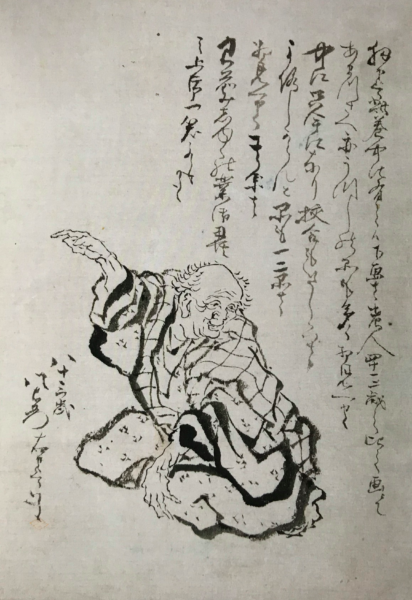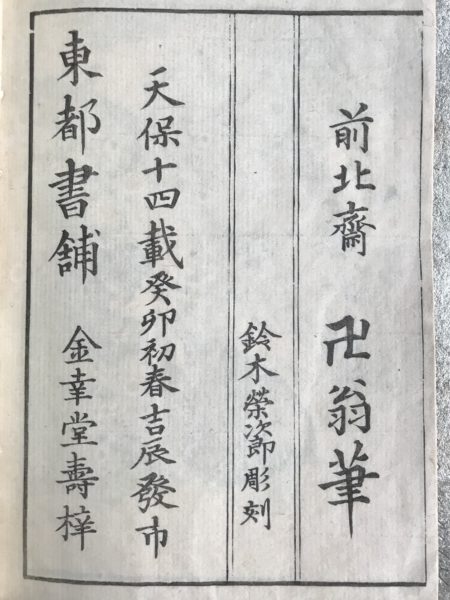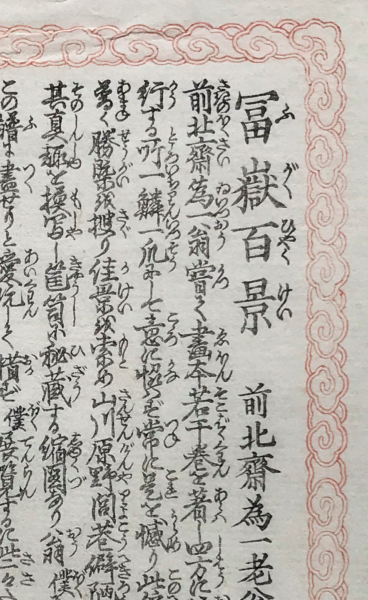We like mysteries, don’t we? Today we go for this fabulous Hokusai self-portrait as a drawing at the end of a letter to … some unidentified publisher. It is signed Hachiemon 八右衛門 with the seal Manji 卍, adding his age as 83 years old 八十三歳, so we know this must date from 1842. Even when we have a translation of the text of the letter – or what remains of the letter – it just stops there. Everybody seems to love the mystery of the addressee – much like what the charm of Beethovens letter to ‘die unsterbliche Geliebte’ is, though there have at least been many speculations. But nobody (as far as I am aware) ever made an attempt to identify the publisher to whom this letter was sent.*

But it cannot really be that difficult, as the letter reads:
Well then, the sketches in this volume were made when I was about forty-one or forty-two; moreover, a number of them duplicates one another. After all these years some of them might be better worked out. The remainder, which you may smile about, should be regarded as immature work from the past.**
There is only one volume of various sketches made into a book and dating from post 1842, thus meeting all the requirements. That is the Manji-ō sōhitsu gafu『卍翁艸筆畫譜』published by Kikuya Kōsaburō 菊屋幸三郎 of Edo. There is no other possible contender, no mistake, it is as simple as that. The Sōhitsu gafu has 17 single and 14 double-page illustrations of various subjects, a perfect mixture for an ‘album of paintings’ as we should understand the common Japanese concept of the ‘gafu’ in the title.
Looking at the plates raises two questions. One concerns the date of the drawings Hokusai mentions. He maintains that these would date from when he was forty-one or two, which would be in Kyōwa, 1800 or 1801, which I cannot believe. They rather seem to date from Bunka, the late 1810s, when he worked on the final volumes of the Hokusai manga, the Hokusai gashiki and the Hokusai soga – leftovers maybe? Another question concerns the fire of 1839 when he was living at Daruma Yokochō 達磨横町 in Azumabashi itchōme, Sumidaku 墨田区吾妻橋一丁目 when he could just grasp his brushes and get safely out of his studio himself, but would loose all his sketches and drawings in the fire, as the Katsushika Hokusai den (上64b-65b) informs us and which mostly came to us through De Goncourt (p. 242). If this were altogether correct and reliable, it seems quite impossible that Hokusai would three years later be sending some thirty plus drawings dating from ‘when I was about forty-one or forty-two.’

Let us now have a closer look at the album that Kikuya Kōsaburō made out of the sketches that Hokusai sent him together with this letter, the Manji-ō sōhitsu gafu. The illustrations are, quite remarkably, just in line with supporting accents in grey, something quite unprecedented, and of a very different nature from what we see in the Hundred Views of Fuji 富嶽百景 albums. According to the colophon, the album was published in Tenpō 14, 1843, year of the Hare, first month, lucky day of the Dragon (Tenpō jūyonsai mizunoto u shoshun kichi tatsu hasshi 天保十四歳癸卯初春吉辰發市). And we find the date of 1843 duly in all literature, as if it shouldn’t puzzle us to find a preface to the volume signed by Tōjō Kindai 1795-1878, the father of Kikuya, signed ‘composed by the Old Kindai, father of the publisher Kōshi, with seal: Kōshizō (Kindai rōjin Tōjō Kōshizō no chichi sen, s: Kōshizō 琴臺老人東條耕子藏父撰 印: 耕子藏) that is surprisingly dated Tenpō, Spring of the year of the Dragon, 1832 (Tenpō mizunoe tatsu no haru 天保壬辰之春) – with the combination mizunoe tatsu unmistakably indicating the year 1832. However, as he writes that the volume was given the title of Album of Paintings with a Free Brush by the Old Manji, this must be a mistake, as Hokusai only announced his change of name to Manji in 1834. The mistake must be in the cyclical date, writing mizunoe tatsu instead of kinoe tatsu 甲辰, which gives 1844.
What happened is this: Kikuya had the drawings that Hokusai sent him worked out and all the blocks had been cut by Suzuki Eijirō (chōkoku 鈴木榮次郞彫刻), even the colophon page with the date of Tenpō 14, First month of 1843. But we are also in the heydays of the Tenpō Reforms 天保の改革 promulgated on 22/V/1841. And from XII/1838 it had been forbidden to display and sell picture books – and the Manji-ō sōhitsu gafu is a picture book – and erotic works in the front of the shop, yes these were difficult times. Hoping to be on the safe side with his plates printed in line and just with grey tones, he then still thought it wiser to wait for better times, maybe next year, and so in the end he dared publish the book in the First month of 1844, as indicated in the preface. A few years later, as the Tenpō Reforms became less strict, around 1847, he also took the risk to bring out a version in colours, under the title Hokusai manga Sōhitsu no bu 北斎漫畫草筆之部.
* I identified the addressee before, but in more obscure locations.
**I was told that Georg Baselitz was inspired to make a series of quite impressive drawings based on the portrait and the translation that he saw in my 1991 Royal Academy exhibition catalogue – he donated ten of these to the British Museum and another ten to the Met, but forgot to give me one.
